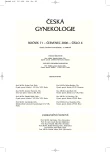Birth Defects’ Occurrence in Offspring of Mothers Taking 1st Trimester Medication in the Czech Republic in 1996-2004
Authors:
A. Šípek 1,2; V. Gregor 3,4; J. Horáček 3,4; D. Mašátová 5
Authors‘ workplace:
Ústav pro péči o matku a dítě, Praha, ředitel doc. MUDr. J. Feyereisl, CSc.
1; Institut postgraduálního vzdělávání ve zdravotnictví, Praha, Katedra gyn. -por., ředitel MUDr. A. Malina, Ph. D.
2; Oddělení lékařské genetiky, Fakultní Thomayerova nemocnice, Praha, ředitel MUDr. P. Malý
3; Institut postgraduálního vzdělávání ve zdravotnictví, Praha, Katedra lékařské genetiky
ředitel MUDr. A. Malina, Ph. D.
4; Ústav zdravotnických informací a statistiky České republiky, Praha, ředitelka Mgr. V. Mazánková
5
Published in:
Ceska Gynekol 2006; 71(4): 284-291
Category:
Original Article
Overview
Objective:
An analysis of birth defects incidence in offspring of mothers taking 1st trimester medication in the Czech Republic in 1996-2004.
Type of study:
A retrospective demographical – epidemiological analysis of data from a National Register of Congenital Anomalies of the Czech Republic.
Methodology:
Data on birth defects in the Czech Republic from the Institute of Health Information and Statistics - National Register of Congenital Anomalies from the 1996 – 2004 period and a control group data on healthy children born to mothers taking medications from the same time period. Data on medication were analyzed in relation to particular defects and were also used in international databases.
Results:
There were 1,125 children born with a birth defect to mothers taking 1st trimester medication making a total of 1,456 particular birth defects. A control group covered 1,321 exposed women giving birth to a child without any birth defect. Some types of congenital heart defects, cleft lip with cleft palate and limb reduction defects. A significantly higher risk was found also in following 5 types of drugs: anticoagulants, antihypertensives, peripheral vasodilatants, urologics and antiepileptics.
Conclusions:
A significantly higher risk was found for the following defects: anencephaly, spina bifida, congenital hydrocephalus, anophthalmia/microphthalmia and auricular and limb reduction defects. Although the results are not always unambiguous and are probably influenced by both information and recall bias, they complement data on adverse effects of drugs in pregnancy in the Czech Republic. They also stress the need for a high preliminary caution in drug prescription and for a complex and individual risk assessement by a clinical geneticist.
Key words:
birth defect, populational teratology, teratogen, incidence, Czech Republic
Labels
Paediatric gynaecology Gynaecology and obstetrics Reproduction medicineArticle was published in
Czech Gynaecology

2006 Issue 4
Most read in this issue
- Etiopathogenesis of the Prolapsed Vaginal Vault after Hysterectomy
- Actual Management of Pregnancies at Risk for Fetal Anemia
- Harmatoma of the Breast – Case Report
- Gynecological Aspects of Thyroid Disorders. A Review
